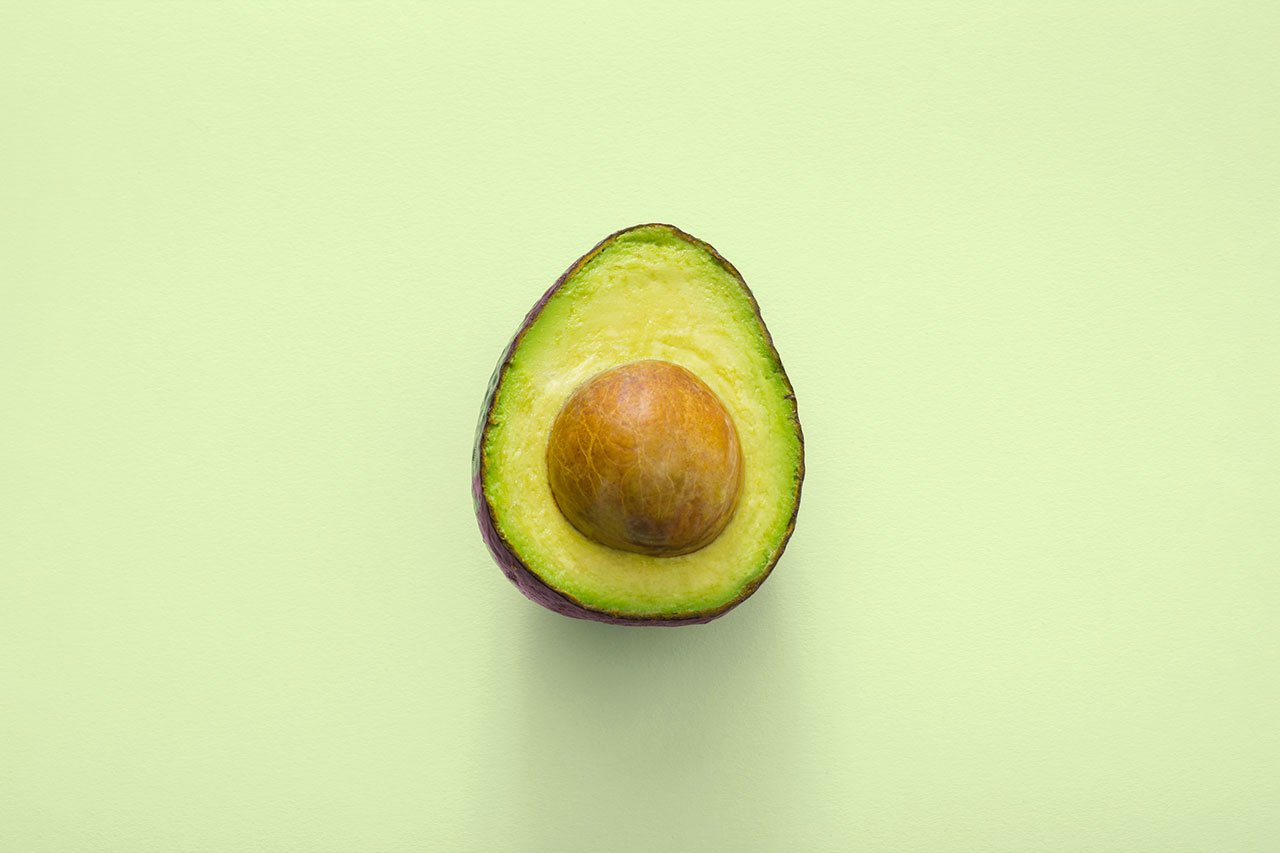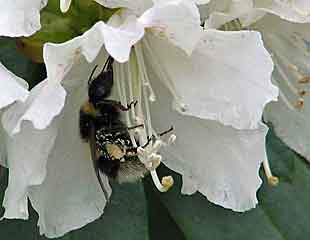
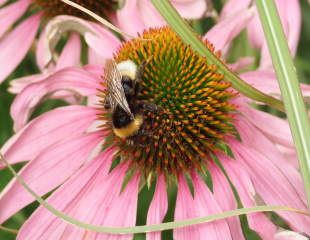
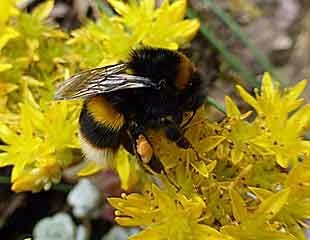
Plants for bees the scientific choice
There are lots of publications containing lists of plants which are attractive to bees. What caught my eye was a scientific survey (details in footnote) by some clever scientists at the University of Sussex, who tried to established exactly which plants are best for bees and pollinators. Some plants are up to 100 times more attractive and the authors concluded that by referring to this list gardeners can make a great difference to the local ecology by planting those plants scientifically proven to be the best. The Survey acknowledged that there are many lists in existence guiding gardeners but that they are not "well grounded based on empirical data". The results help gardeners to select bee and insect friendly plants. The scientists based their research on popular garden plants, especially Lavender and so are available to all. The survey is very helpful, although restricted to 32 popular garden plants, which is its limitation, and just walking around gardens tells us there are many more bee friendly plants.
Bees and flying insects depend on plants to gather nectar and pollen. It is a symbiotic relationship, as plants depend on bees and flying insects to transfer pollen on their bodies moving from flower to flower, which leads to fertilisation and setting seeds and berries. In each of the images above the pollen can be seen on the bee and in the pollen baskets. At one time, our landscape had large amounts of hay meadows with wild flowers and the use of pesticides was less common. As the habitat has gone, it is a familiar story retold, the wildlife dependent on that habitat have reduced in numbers.
If you want to identify what sort of bee is in your garden, this is a great free guide from Friends of the Earth with good clear descriptions and illustrations.
Below are links to some bee friendly plants on the web site with advice on how and where to grow them. The list below reflects many of the plants in the survey; they are proven to attract bees.
The hardy Geranium, common name Cranesbill is much loved by the bees, who love blue making a blue Geranium a bee magnet. It is about how bees see colour, there is a scientific explanation but here is a peaceful little video of the bees buzzing blue.
Clever bees
2021 research by University College London has shown that bees alter their behaviour when pests threaten the hive. Even though bees are social creatures, when pests threaten they increase social distancing, reduce the foraging dances and increase grooming.
They established this in their study of two colonies, one under threat and one pest free and considering how their behaviour differed.
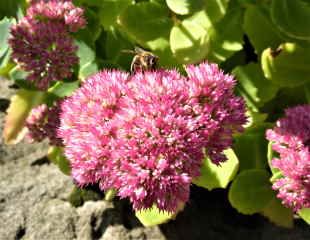
Bees Love blue a relaxing video of summer bees
Bee Friendly Plants
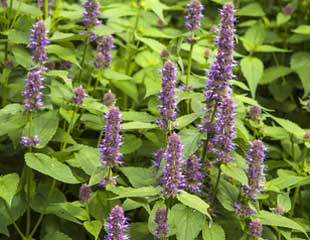
Agastache also known as Hyssop
Top of the bee list is Agastache, common name Hyssop, an aromatic flowering herbaceous perennial plant which tends to be short lived particularly in cold areas, but is highly attractive to bees, especially varieties of bumblebees. Agastache is best grown in a sunny site on well-drained soil and it will flower from midsummer until autumn. Agastache grows up to .5m and forms a small bushy plant with flowers which are usually blue or mauve and the leaves scented. A. 'Blue Fortune' has the RHS Garden Merit award and is a good choice, and A. 'Black Adder' is also popular and said to be hardier. H4 hardy which reflects the fact that a cold wet winter can be damaging.
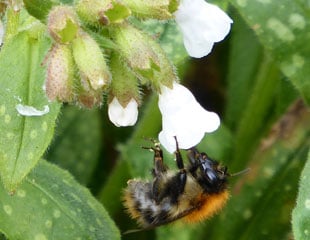
Pulmonaria
Pulmonaria are a good source of early nectar for the solitary bees as they emerge and are foraging for food. I took this image in early April although I have seen bees on Pulmonaria in February on a mild day. The Pulmonaria illustrated is P. 'Sissinghurst White' which flowers from March through to April and make a good ground cover plant suitable for damp shade. Pulmonarias are easy to grow - tips and advice
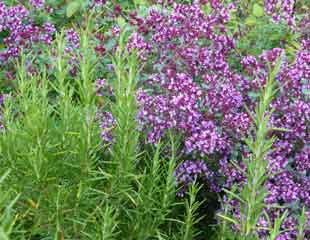
Herb Oregano also known as Marjoram
High on the list of bee friendly plants is Oregano also known as Marjoram which attracts bees and a diverse range of pollinators. Oregano, in common with many herbs, is very attractive to bees and planting a herb garden is a good way to bring bees into the garden. Oregano is an all round friend of wildlife as it will attract bees, hover flies and butterflies. As a warning it is a prolific self seeder and needs to be removed as it can be a bit of a garden thug.
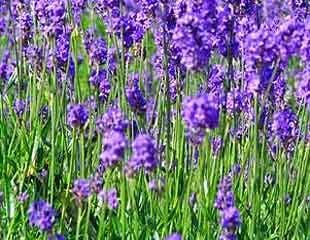
Lavender
We know from walking around any garden how much the bees love lavender. The scientific survey does feature Lavenders heavily, and it seems that L. x intermedia which includes L. Hidcote Giant and Gros bleu did very well as did L.Angustifolia. All the Lavenders did very well in attracting bees. Lavender needs good drainage and can be unhappy in wet ground especially over winter: tips on growing Lavender.
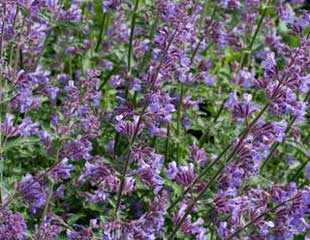
Nepeta also known as Cat Mint
If the growing conditions are not suitable for Lavender an alternative which yields soft blue flowers and attracts bees is Nepeta, Cat Mint which also features highly on the survey. Nepeta has aromatic leaves and a long flowering period, loved by bees and pollinators and easy to grow. (Also loved by cats.) Nepeta is an easy to grow, tough perennial which will come up reliably every year.
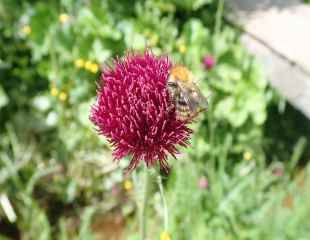
Cirsium rivulare 'Atropurpureum
The common name of this thistle is brook or river thistle, and long before it became trendy at Chelsea it was a humble, damp loving thistle that the bees just cannot get enough of. I grow a clump down by a stream, where it is often boggy and in the summer it is covered in bees, dozens of them buzzing away.
It is tough and will grow in most places but is very useful to plant in damp areas where it will thrive.
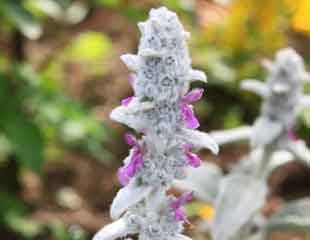
Stachys bysantina also known as Lamb's ears.
Stachys byzantina, common name Lamb's ears is a hardy perennial, grown for its soft downy leaves. It has small, insignificant light purple flowers and although the flowers do look flashy, they are attractive to bees for months, even as they fade. In late summer when I am keen to cut it back I have to stop myself as I see bee after bee land on it. Lamb's ears is also a favourite of one particular type of bee, the wool carder bee. Female wood carder bee harvests hairs from the plant leaves to make nests. By growing Stachys you are providing the materials for the wool carder bee to build its nest.
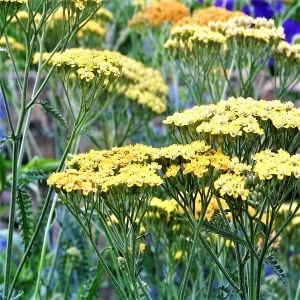
Achillea
Another plant attractive to bees, on this occasion not blue is Achillea. Easy to grow preferring a drier sunny spot it flowers for months and the fading flower heads look attractive. Achillea have a wide range of colours, pastels, terracotta, strong cerise bright yellows and soft pink and all have attractive feathery foliage and are enjoyed by bees.
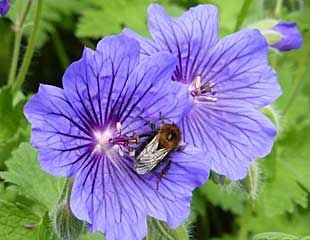
Geranium common name Cranesbill
The image shows Blue Geranium ibericum which is often covered with bees. Most of the Geraniums are popular with bees, and those with violet and blue flowers are favoured the most. Geraniums are easy to grow, generally unfussy about soil conditions. This little video shows the bees enjoying the blue Geranium ibericum, planted with Chives, making a bee friendly combination.
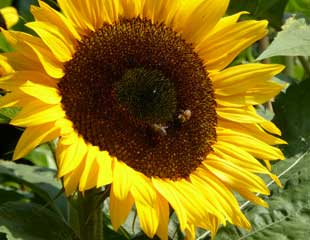
Sunflowers
Sunflowers are ideal for bees and are easy to grow. The speed at which they grow and their lovely large flower heads make them great fun for children to grow and to observe bees helping to dispel any natural fear they may have of bees.
Bees do like simple flower shapes and the open daisy type flowers are generally liked by bees.
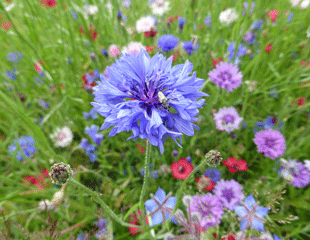
Wildflowers
Wildflowers are good plants for bees and pollinators. Wildflowers and wildflower meadows are often associated with large gardens but it is perfectly possible, and easy, to create a small wildflower patch will be colourful for weeks and buzzing. Annals create great colour and are attractive to bees; advice on how to create your own wildflower patch.
See also illustrated on other pages Sedum, Chives, Perovskia common name Russian Sage, Monarda also known as Bee Balm, and Cotoneaster.
No one makes bees more interesting than Prof. Dave Goulson and his comments on bee conservation are fascinating. The link between damage to bees and Neonicotinoids is well illustrated in his explanation of experiments he has undertaken and there is currently an EU ban on 3 pesticides in this group. Listening to Prof. Goulson is both fascinating and a powerful argument for gardening organically. What he doesn't know about bees is just not worth knowing. He also founded the Bumble Bee conservation trust which has some great information about bees and how to get involved with the charity.
The survey referred to above : Functional Ecology 2014, 28, 364-374 Quantifying variation among garden plants in attractiveness to bees and other-visiting insects by Mihail Garbuzov and Francis L.W. Ratnieks
Last updated 30.12.2021
Heading Text
This is an Image & Text block. Click on this text to start editing and enter your own text with some basic formatting. Just click anywhere outside the text box when you're done to continue working on the rest of your page.
To change the layout and appearance of a block, such as the size of its images and columns, click on the Change Layout button on the block toolbar, to the right of each block.
